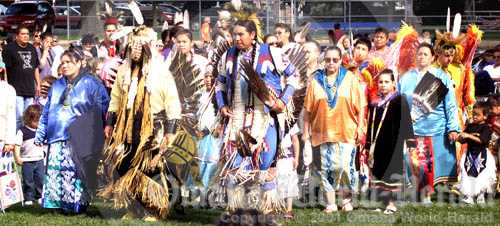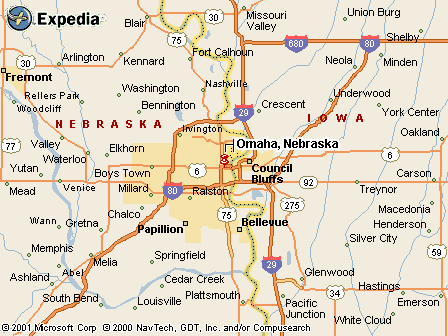|
|
Canku Ota |
|
|
(Many Paths) |
||
|
An Online Newsletter Celebrating Native America |
||
|
October 6, 2001 - Issue 46 |
||
|
|
||
|
Powwow Promotes Cultures and Tolerance |
||
|
by Cindy Gonzalez Omaha World-Herald-September 23, 2001 |
||
|
Photo by Keith Sievers |
 Howard Wolf,
an elder in the Omaha tribe, sat near his family's tepee at an intertribal powwow Saturday and reflected on the
event's start 10 years ago. Howard Wolf,
an elder in the Omaha tribe, sat near his family's tepee at an intertribal powwow Saturday and reflected on the
event's start 10 years ago. Two drums, some 20 dancers and a smattering of exhibition booths greeted visitors then. Saturday's cultural display was on a much grander scale: more than 100 dancers, eight pulsating drums, dozens of booths, hundreds of new faces. "We had sort of pitiful beginnings," said Wolf, 76, who was on the original planning committee. "It's gotten bigger. That's good. If we're going to survive as a people, if we're going to understand each other, we need things like this." Under sunny skies, the 10th annual Intertribal Powwow drew more than 2,000 people to the Fort Omaha campus of Metropolitan Community College. The all-day event united American Indians from across the region - including members of the Omaha, Winnebago, Ponca, Santee Sioux and Lakota Sioux - to celebrate traditions and heritage. The celebration, however, was not without solemn reflection for victims of the Sept. 11 terrorist attacks. Before the grand entry, Master of Ceremonies Chris "Hay-na" Grezlik asked all to stand and remove their hats while the Maza Kute Drum played a memorial song. Then, with an elder carrying an eagle-feather staff, tribal members danced onto the arena. Watching them were people like Michelle Perales of Omaha and her three sons. "I wanted to see a powwow," Perales said. "I'd never been to one, and I wanted the kids to learn about them." Dillon Perales, 10, was fascinated by eagle plumes, brilliant-colored beads and the tin cone jingles sewn on dancers' outfits. "There's a lot of dresses," Dillon said, "and a lot of neat feathers." Thomas Hinman, 9, of the northern Ponca tribe was in full regalia, including a headdress of porcupine and deer-tail hair. "Dancing makes me feel great," Thomas said. "It makes me sad, too, for the old people." When children dance, Wolf said, they honor their elders who have passed on. It is through such traditions and gatherings as the powwow, the elder said, that young Indians and others learn about the culture and gain an understanding and tolerance of different people. "We have a long road to travel," Wolf said. "By better understanding each other, that road will be traveled with more peace and harmony." |
|
|
|
|
||
|
|
||
| Canku Ota is a free Newsletter celebrating Native America, its traditions and accomplishments . We do not provide subscriber or visitor names to anyone. Some articles presented in Canku Ota may contain copyright material. We have received appropriate permissions for republishing any articles. Material appearing here is distributed without profit or monetary gain to those who have expressed an interest. This is in accordance with Title 17 U.S.C. section 107. | ||
|
Canku Ota is a copyright © 2000, 2001 of Vicki Lockard and Paul Barry. |
||
|
|
|
|
|
The "Canku Ota - A Newsletter Celebrating Native America" web site and its design is the |
||
|
Copyright © 1999, 2000, 2001 of Paul C. Barry. |
||
|
All Rights Reserved. |
||

